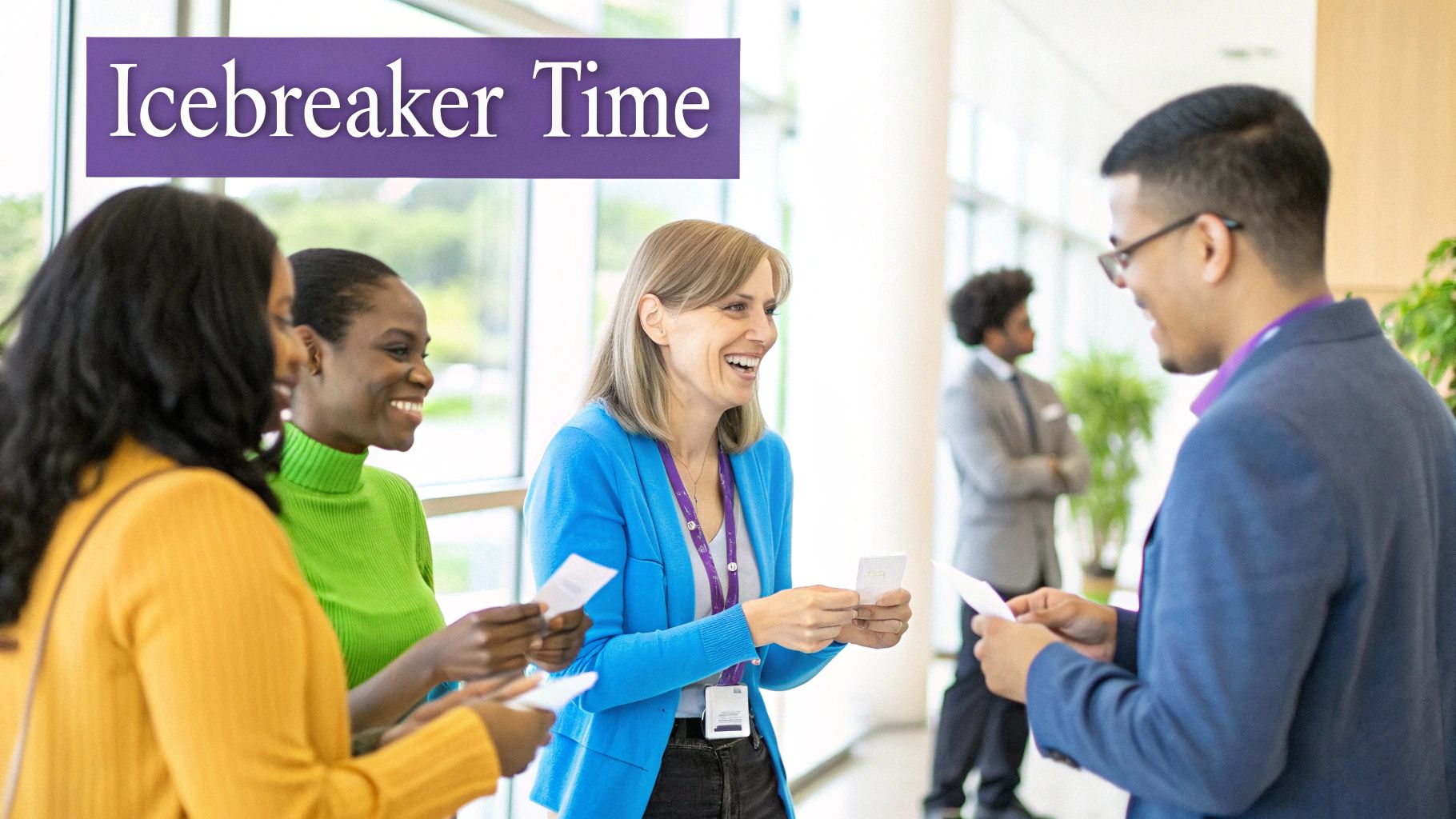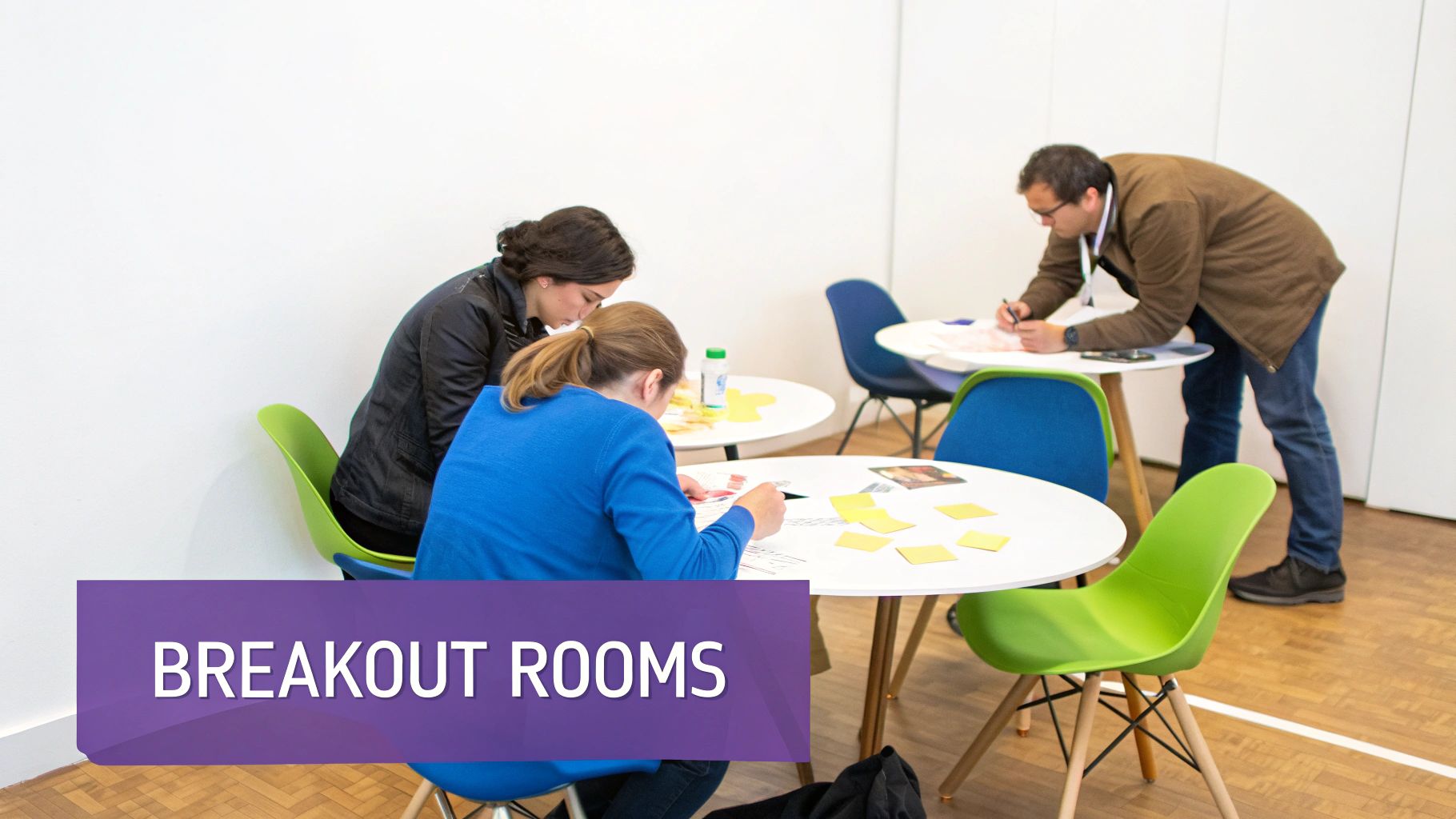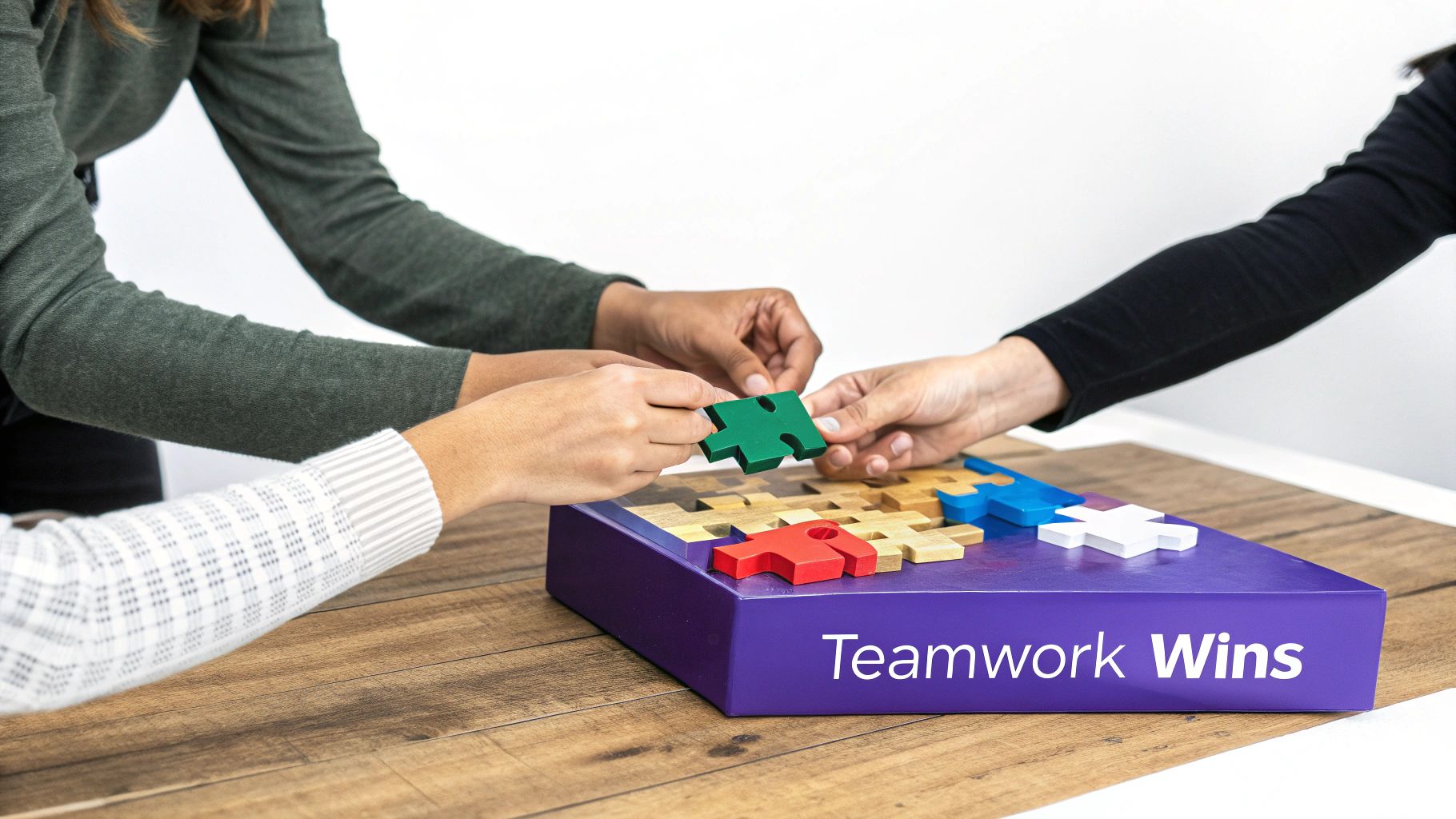Tired of the same old virtual stand-ups and hybrid check-ins? Meetings don't have to be a drain on energy and creativity. The right activity can transform a passive audience into an engaged, collaborative team, making every session more productive and enjoyable. This shift is crucial for maintaining momentum and fostering a strong culture, especially in distributed work environments.
This guide provides a comprehensive list of powerful group meeting activity ideas designed specifically for today's remote and hybrid workplaces. We will move beyond generic advice and dive into practical, actionable strategies that you can implement immediately. From dynamic icebreakers that build genuine connections to structured brainstorming sessions that drive innovation, each idea is crafted to boost participation and deliver tangible results.
You will find clear, step-by-step instructions for each activity, including objectives, time requirements, and facilitation tips. We will also highlight how a dedicated tool like Bulby can supercharge these exercises, turning mundane meetings into vibrant hubs of creative problem-solving. Whether you are leading a quick daily huddle or an in-depth workshop, these activities will help you build a more connected, creative, and effective team. Let's get started.
1. Icebreaker Activities
Icebreaker activities are quick, structured exercises designed to warm up a group, encourage introductions, and build rapport at the start of a meeting. They serve as excellent group meeting activity ideas because they break down social barriers and help team members, especially in remote or hybrid settings, connect on a more personal level. This fosters a more inclusive and collaborative atmosphere for the rest of the session.

These activities are highly adaptable and can be tailored to any team's dynamic and the meeting's overall objective.
How to Implement Icebreaker Activities
The key is to keep them light, brief, and engaging. For a virtual team, you could use a shared digital whiteboard for a game of "Human Bingo," where each square contains a fact like "Has visited another country" or "Speaks more than one language." Another popular choice is "Two Truths and a Lie," where participants share three statements about themselves, and the team votes on which one is the falsehood. These simple interactions create shared experiences and boost psychological safety.
Best Practices for Facilitators
- Keep it Brief: Aim for 5-10 minutes. The goal is to energize the team, not consume the meeting.
- Make it Optional: Allow individuals to "pass" if they aren't comfortable sharing. This respects personal boundaries.
- Align with Culture: Choose an activity that fits your team's personality. A fun, high-energy game might be great for one team but awkward for another.
- Test Your Tech: If using a digital tool, do a quick run-through beforehand to ensure it works smoothly for everyone.
For a deeper dive into specific exercises, explore these other effective icebreakers for team building.
2. Brainstorming Sessions
Brainstorming sessions are collaborative activities designed to generate a large volume of creative ideas and solutions to a specific problem without immediate judgment. These sessions leverage the collective intelligence of the group, encouraging out-of-the-box thinking based on principles popularized by figures like Alex Osborn and Edward de Bono. They are essential group meeting activity ideas for fostering innovation and tackling complex challenges, from product development at tech companies to campaign ideation at advertising agencies.
This approach is highly effective because it separates idea generation from evaluation, allowing participants to share freely and build on each other's thoughts.
How to Implement Brainstorming Sessions
The goal is to create an open and non-hierarchical environment where all ideas are welcomed. For remote teams, a digital whiteboard can serve as a canvas for virtual sticky notes, allowing everyone to contribute simultaneously. A popular technique is "Round Robin Brainstorming," where each person shares one idea at a time in a circular fashion. This ensures equal participation and prevents a few dominant voices from controlling the conversation. The focus is purely on quantity and creativity in this initial phase.
Best Practices for Facilitators
- Set a Clear Goal: Define the problem or question the team is trying to solve before starting. A focused objective leads to more relevant ideas.
- Encourage "Yes, and…": Promote a culture of building on ideas rather than shutting them down. This improvisational rule fosters positive momentum.
- Separate Generation from Evaluation: Dedicate distinct time blocks for generating ideas and then for discussing or critiquing them.
- Use Visual Tools: Capture every idea on a shared space like a whiteboard or digital collaboration tool to keep thoughts organized and visible to all.
For a structured approach, you can explore this detailed brainstorming session template.
3. Breakout Room Discussions
Breakout room discussions involve dividing a large meeting into smaller, more intimate subgroups to explore specific topics in-depth. These focused conversations are powerful group meeting activity ideas, as they encourage active participation from every member, preventing a few dominant voices from controlling the entire discussion. This approach is highly effective in both virtual meetings on platforms like Zoom and in-person workshops.

This method ensures that complex problems can be tackled from multiple angles simultaneously, generating a richer set of ideas and solutions.
How to Implement Breakout Room Discussions
To implement this, clearly define the goal for each small group. For example, during a remote team retreat, you could create breakouts for different departments to brainstorm their specific goals for the next quarter. In a large all-hands meeting, you might use them to gather feedback on a new company-wide initiative, assigning a different aspect of the initiative to each group. After the allotted time, each group's designated spokesperson shares key takeaways with the larger team.
Best Practices for Facilitators
- Provide Clear Prompts: Give each group a written set of questions or a specific problem to solve.
- Set a Strict Time Limit: Clearly communicate how much time the groups have and give them a two-minute warning before reconvening.
- Assign a Facilitator: Designate a leader or note-taker in each room to keep the conversation on track and capture key points.
- Share a Common Goal: Ensure all groups understand how their discussion contributes to the overall meeting objective.
To master this and other similar methods, you can explore these effective group facilitation techniques.
4. Presentation and Feedback Sessions
Presentation and feedback sessions are structured opportunities for team members to present their work, projects, or ideas to the group and receive constructive feedback. These sessions are powerful group meeting activity ideas because they promote knowledge sharing, enhance communication skills, and build a culture of continuous improvement. This format allows colleagues to learn from one another's progress and challenges, fostering accountability and collective growth.
These sessions are highly effective for project updates, research findings, or pitching new initiatives, turning passive meetings into active learning forums.
How to Implement Presentation and Feedback Sessions
Establish a clear format where one or more team members present for a set time, followed by a dedicated Q&A and feedback period. For example, a tech team might hold a weekly "show-and-tell" for engineers to demo new features. A marketing team could use this structure for campaign post-mortems. The key is creating a safe space for open dialogue. To make your sessions more dynamic, explore these ideas for interactive presentations that can boost audience participation.
Best Practices for Facilitators
- Use a Framework: Guide participants to give constructive feedback using a model like SBI (Situation, Behavior, Impact).
- Set Clear Objectives: Ensure the presenter and audience know the goal of the presentation beforehand.
- Rotate Presenters: Give everyone on the team an opportunity to present and receive feedback over time.
- Allocate Ample Time: Protect time for meaningful discussion and questions after the presentation to avoid rushing.
To further develop your team's presentation skills, discover these interactive exercises for presentations.
5. Team Building Exercises
Team building exercises are collaborative activities specifically designed to strengthen relationships, trust, and communication among team members. As group meeting activity ideas, they go beyond simple icebreakers by creating shared challenges that require genuine teamwork to overcome. This process builds camaraderie and improves team dynamics, which translates directly into better workplace performance and morale.

These activities are highly effective because they take teams out of their typical work environment, encouraging them to interact in new and meaningful ways.
How to Implement Team Building Exercises
Implementation can range from in-person events like a volunteer day or a competitive scavenger hunt to virtual experiences such as an online escape room. For a hybrid team, you could organize a cooking class challenge where remote and in-office participants join via video to create the same dish. The goal is to choose an activity that requires communication, problem-solving, and mutual support to succeed. To foster better collaboration and morale within your team, consider integrating these next-level corporate team building activities into your meeting schedule.
Best Practices for Facilitators
- Align with Interests: Choose activities that genuinely appeal to your team's personalities and physical capabilities.
- Ensure Inclusivity: Make sure everyone can participate comfortably, regardless of their role or physical ability.
- Debrief Afterwards: Dedicate time after the activity to discuss what the team learned and how they can apply those lessons to their work.
- Mix It Up: Balance competitive elements with cooperative challenges to cater to different personalities and build a well-rounded team.
For more inspiration, explore these other powerful activities that build teamwork.
6. Round-Robin or Popcorn Sharing
Round-robin or popcorn sharing is a structured yet flexible method for ensuring every participant has a chance to speak. It’s one of the most effective group meeting activity ideas for promoting equitable contribution. In a round-robin, each person shares in a set order, while the popcorn style allows individuals to "pop" in and share when they feel ready, creating a more spontaneous flow.
This activity is designed to democratize the conversation, preventing a few dominant voices from controlling the discussion. It is highly versatile and works well for team check-ins, daily stand-ups, or gathering feedback on a specific prompt, ensuring all perspectives are heard.
How to Implement Round-Robin or Popcorn Sharing
To start a round-robin, simply establish an order (e.g., clockwise on video call screens) and have each person share their thoughts on a given topic, like "What's one win from this week?" For popcorn sharing, pose a question and let team members jump in as they please. A facilitator can guide the process by saying, "Who wants to pop next?" to encourage participation. This approach is excellent for brainstorming sessions where ideas build on one another.
Best Practices for Facilitators
- Set a Time Limit: Suggest a brief time limit per person (e.g., 60-90 seconds) to maintain momentum and respect everyone's time.
- Offer the Option to Pass: Make it clear that participants can say "pass" if they don't have anything to share. This reduces pressure.
- Use Open-Ended Questions: Prompt sharing with questions that encourage more than a yes or no answer.
- Vary the Starting Point: For round-robins, start with a different person each time to avoid the same people always going first or last.
- Acknowledge Contributions: Briefly paraphrase or thank each person after they share to show they have been heard and understood.
7. Interactive Polls and Surveys
Interactive polls and surveys are real-time data collection tools used to gather opinions, gauge understanding, or make group decisions efficiently. As one of the most versatile group meeting activity ideas, they transform passive listeners into active participants by giving everyone an equal voice. This method provides instant, quantifiable feedback, making it perfect for hybrid teams that need to quickly align on priorities or measure sentiment.
These tools are highly effective for capturing a snapshot of the group's perspective without derailing the meeting's flow.
How to Implement Interactive Polls and Surveys
Implementation is straightforward with platforms like Slido or Mentimeter. You can pose a question such as, "Which of these three product features should we prioritize for the next sprint?" and have team members vote instantly from their devices. The results appear on-screen in real-time, providing an immediate basis for discussion. This is especially useful for making democratic decisions or checking comprehension after a training segment.
Best Practices for Facilitators
- Keep it Clear: Frame questions so they are unambiguous and easy to answer quickly.
- Allow Anonymity: Use anonymous mode for sensitive topics to encourage honest and candid responses.
- Discuss the Results: Don't just show the data. Immediately discuss the implications and what the results mean for the team.
- Vary Question Types: Mix multiple-choice, word clouds, and open-ended questions to keep engagement high.
- Test Your Tech: Ensure your polling software is set up and works correctly before the meeting begins to avoid delays.
8. Role-Playing and Simulations
Role-playing and simulations are structured activities where participants adopt different roles or perspectives to navigate hypothetical scenarios. These exercises serve as powerful group meeting activity ideas for practical skill development, allowing team members to practice communication, problem-solving, and empathy in a controlled, low-stakes environment. This method is particularly effective for training, conflict resolution, and preparing for challenging real-world interactions.
By stepping into someone else's shoes, participants gain a deeper understanding of different viewpoints, which is invaluable for teams focused on customer service, sales, or leadership.
How to Implement Role-Playing and Simulations
The core of this activity is creating a realistic and relevant scenario. For example, a customer service team could role-play handling a call with an unhappy client, or a product team could simulate a difficult negotiation with a stakeholder. One person plays the customer or stakeholder, while another practices the company's approved response protocol. The rest of the team can act as observers, providing constructive feedback afterward.
Best Practices for Facilitators
- Define Clear Objectives: Ensure everyone understands what skill or outcome the simulation is designed to improve.
- Keep Scenarios Relevant: Use situations that your team is likely to encounter in their actual work.
- Encourage Volunteers: Ask for volunteers before assigning roles to increase comfort and engagement. Create observer roles for those who prefer not to participate directly.
- Facilitate a Debrief: The most crucial part is the post-simulation discussion. Guide a conversation about what went well, what was challenging, and what lessons can be applied moving forward.
9. Silent Brainstorming or Brainwriting
Silent brainstorming, also known as brainwriting, is a structured approach where participants individually write down ideas before any group discussion. This method is one of the most effective group meeting activity ideas because it levels the playing field, preventing louder voices from dominating the conversation and allowing introverted team members to contribute their thoughts fully and without interruption. This ensures a wider and more diverse range of ideas is generated.
This technique is particularly useful for complex problem-solving or innovation sessions where deep, individual thinking is crucial before collaborative refinement.
How to Implement Silent Brainstorming
The process is straightforward and adaptable to both in-person and virtual settings. Begin by clearly defining the problem or question. Then, give each participant a set time (e.g., 10-15 minutes) to write down as many ideas as possible on their own, using digital tools like Miro or Google Docs for remote teams, or physical sticky notes for co-located groups. Once the time is up, all ideas are collected and shared with the group anonymously for discussion, clustering, and prioritization.
Best Practices for Facilitators
- Set Clear Time Limits: Honor the allocated time for silent generation to maintain focus and momentum.
- Enforce Silence: Ensure the writing phase is truly silent to protect individual thought processes.
- Discuss Ideas, Not People: When reviewing ideas, focus the conversation on the content of the ideas themselves, not on who submitted them.
- Cluster and Build: Group similar ideas into themes and then use the collective insights as a springboard for deeper collaborative discussion.
For those looking to enhance their brainstorming sessions, exploring techniques from design firms like IDEO can provide valuable inspiration.
10. Retrospectives and Reflection Sessions
Retrospectives are structured meetings where teams reflect on a recent work period, such as a project or sprint, to identify what went well, what didn’t, and how to improve moving forward. These sessions are excellent group meeting activity ideas because they transform lessons learned into actionable steps, fostering a culture of continuous improvement. This approach empowers teams to collaboratively solve problems and refine their processes.
These activities are highly valuable for any team, from Agile development squads conducting sprint retrospectives to marketing teams holding post-campaign debriefs.
How to Implement Retrospectives and Reflection Sessions
A common framework is the "Start, Stop, Continue" method, where team members suggest actions to start doing, stop doing, and continue doing. Using a virtual whiteboard, a facilitator can create three columns for this. Each participant adds their thoughts on digital sticky notes, followed by a group discussion to identify themes and agree on concrete action items. This ensures everyone's voice is heard and creates a clear path forward.
Best Practices for Facilitators
- Establish Psychological Safety: Begin the meeting by emphasizing that the goal is to improve processes, not to assign blame.
- Use a Clear Framework: Stick to simple formats like "Start, Stop, Continue" or "What Went Well, What Didn't, What to Improve" to keep the discussion focused.
- Focus on Action: Ensure every retrospective ends with specific, assigned action items and deadlines. Follow up on these items at the beginning of the next session.
- Keep it Timely: Limit sessions to 30-60 minutes to maintain energy and focus on the most critical takeaways.
For more frameworks and facilitation tips, explore resources from organizations like the Agile Alliance.
10-Item Comparison: Group Meeting Activities
| Activity | Implementation Complexity 🔄 | Resource Requirements ⚡ | Expected Outcomes ⭐📊 | Ideal Use Cases 💡 | Key Advantages ⭐ |
|---|---|---|---|---|---|
| Icebreaker Activities | Low 🔄 | Minimal ⚡ (5–15 min, facilitator) | Improved rapport ⭐ / greater meeting engagement 📊 | Meeting starts, mixed-size groups | Quick rapport-building; scalable |
| Brainstorming Sessions | Medium 🔄🔄 | Moderate ⚡⚡ (facilitator, whiteboard, 20–60 min) | High idea volume ⭐ / creative options 📊 | Product ideation, marketing campaigns, innovation workshops | Generates many ideas; leverages diverse perspectives |
| Breakout Room Discussions | Medium 🔄🔄 | Moderate ⚡⚡ (facilitators per group, tech for virtual) | Deeper topic exploration ⭐ / increased participation 📊 | Large meetings, virtual workshops, conferences | Parallel discussions; safer space for introverts |
| Presentation and Feedback Sessions | Medium 🔄🔄 | Moderate ⚡⚡ (presenters, time, visual aids) | Skill development ⭐ / knowledge transfer 📊 | Project updates, training, peer reviews | Improves communication; builds accountability |
| Team Building Exercises | High 🔄🔄🔄 | High ⚡⚡⚡ (time, budget, logistics; 1–4 hrs) | Stronger trust ⭐ / morale boost 📊 | Offsites, retreats, morale initiatives | Long-term cohesion; practical teamwork skills |
| Round-Robin / Popcorn Sharing | Low 🔄 | Minimal ⚡ (timekeeping) | Inclusive input ⭐ / quick status snapshots 📊 | Daily standups, quick check-ins, retros | Ensures everyone is heard; simple to run |
| Interactive Polls and Surveys | Low–Medium 🔄🔄 | Moderate ⚡⚡ (polling tools, internet) | Immediate insights ⭐ / data-driven decisions 📊 | Large or remote meetings, voting, training checks | Fast, anonymous feedback; measurable results |
| Role-Playing & Simulations | High 🔄🔄🔄 | High ⚡⚡⚡ (facilitation, scenarios, time) | Practical skill gains ⭐ / empathy building 📊 | Training, conflict resolution, sales practice | Realistic practice; behavior change potential |
| Silent Brainstorming / Brainwriting | Medium 🔄🔄 | Moderate ⚡⚡ (sticky notes or digital tools) | Higher idea quality ⭐ / reduced groupthink 📊 | Design sprints, ideation with introverts | Equal participation; documented ideas |
| Retrospectives & Reflection Sessions | Medium 🔄🔄 | Moderate ⚡⚡ (facilitator, documentation, regular cadence) | Continuous improvement ⭐ / process fixes 📊 | Agile teams, post-project reviews, learning loops | Actionable improvements; fosters accountability |
Turn Your Meetings into a Strategic Advantage
The difference between a meeting that drains energy and one that inspires innovation often comes down to one simple factor: intentional design. Moving past the default agenda of passive updates and one-way monologues is the first step toward building a more creative, engaged, and effective team. The group meeting activity ideas we've explored, from silent brainwriting to dynamic role-playing simulations, are more than just ways to fill the time. They are strategic tools for unlocking your team's collective intelligence.
By deliberately incorporating these activities, you foster an environment of psychological safety where every voice is heard. You encourage diverse thinking by providing multiple channels for contribution and generate truly groundbreaking solutions by structuring collaboration. The key is to be purposeful in your selection.
Key Takeaways for Transforming Your Meetings
- Align Activities with Goals: Don't choose an icebreaker just for the sake of it. Select an activity that directly supports the objective of your meeting. A retrospective requires different tools than a forward-looking brainstorming session.
- Variety is Essential: Relying on the same format every time leads to stagnation. Mix and match activities like breakout rooms, interactive polls, and round-robin sharing to keep energy high and accommodate different communication styles.
- Facilitation Matters: The best group meeting activity ideas can fall flat without clear instructions and active facilitation. Set the stage, explain the "why," manage the time, and guide the conversation to ensure a productive outcome.
Actionable Next Steps
To make this a reality, start small. Pick one upcoming meeting and replace a standard agenda item with a more interactive format. Instead of a simple Q&A, try a structured feedback session. Instead of an open-ended discussion, use a silent brainstorming activity to gather initial thoughts without bias.
Observe the impact on engagement and the quality of the output. As you build confidence, you can begin to design entire meeting flows around these powerful collaborative techniques. This approach transforms meetings from a necessary calendar entry into your team's most valuable strategic asset, a dedicated time for connection, creation, and progress. The right group meeting activity ideas don't just make meetings better; they make your team better.
Ready to elevate your brainstorming sessions from chaotic to world-class? Bulby provides the guided structure, creative prompts, and collaborative tools you need to run powerful ideation workshops effortlessly. Stop guessing and start generating brilliant ideas by trying Bulby with your team today.

